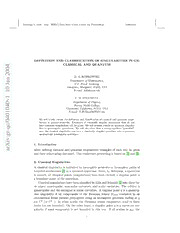Table Of ContentFebruary7,2008 2:43 WSPC/TrimSize: 9.75inx6.5inforProceedings Definition
DEFINITION AND CLASSIFICATION OF SINGULARITIES IN GR:
4 CLASSICAL AND QUANTUM
0
0
2
D. A.KONKOWSKI
n
a Department of Mathematics,
J U.S. Naval Academy,
0 Annapolis, Maryland, 21402, USA
1 E-mail: [email protected]
1
T. M. HELLIWELL
v
0 Department of Physics,
4 Harvey Mudd College,
0 Claremont, California, 91711, USA
1 E-mail: T [email protected]
0
4
0 We will briefly review the definition and classification of classical and quantum singu-
/ larities in general relativity. Examples of classically singular spacetimes that do not
c
have quantum singularitieswillbegiven. We willpresent resultson quantum singular-
q
ities in quasiregular spacetimes. We will also show that a strong repulsive ”potential”
-
r near the classical singularity can turn a classically singular spacetime into a quantum
g mechanicallynonsingularspacetime.
:
v
i
X
1. Introduction
r
a After defining classical and quantum singularities examples of each will be given
andtheir relationshipdiscussed. This conferenceproceedingisbasedon[1]and[2].
2. Classical Singularities
A classical singularity is indicated by incomplete geodesics or incomplete paths of
bounded acceleration[3] in a maximal spacetime. Since, by definition, a spacetime
is smooth, all irregular points (singularities) have been excised; a singular point is
a boundary point of the spacetime.
ClassicalsingularitieshavebeenclassifiedbyEllisandSchmidt[4]intothreeba-
sic types: quasiregular, non-scalar curvature, and scalar curvature. The mildest is
quasiregularand the strongestis scalarcurvature. A singular point q is a quasireg-
ular singularity if all components of the Riemann tensor Rabcd evaluated in an
orthonormal frame parallel propogated along an incomplete geodessic ending at q
are C0 (or C0−). In other words, the Riemann tensor components tend to finite
limits (or are bounded). On the other hand, a singular point q is a curvature sin-
gularity if some component is not bounded in this way. If all scalars in gab, the
1
February7,2008 2:43 WSPC/TrimSize: 9.75inx6.5inforProceedings Definition
2
antisymmetric tensor ηabcd and Rabcd nevertheless tend to a finite limit (or are
bounded), the singularity is non-scalar,but if any scalar is unbounded, the point q
is a scalar curvature singularity.
3. Quantum Singularities
Horowitz and Marolf [5] have defined a static spacetime as quantum mechanically
singular if the spatial portion of the Klein-Gordon wave operator is not essentially
self-adjoint on a C∞ domain in L2, a Hilbert space of square integrable functions.
0
In this case the evolution of the test quantum wave packet is not uniquely deter-
mined by the initial wavefunction. Using this definition they found that Reissner-
Nordstro¨m, negative mass Schwarzschild, and the 2D cone remain singular when
probedbyquantumwavepackets,butcertainorbifoldspacetimes,extremeKaluza-
Klein black holes, and some other string theory examples are nonsingular. In an-
other context, Kay and Studer [6] have also shown that neither the 2D cone nor a
thin idealized cosmic string have essentially self-adjoint wave operators.
4. Quasiregular Spacetimes
A quasiregular spacetime is a spacetime with a classical quasiregular singularity.
Conicalsingularitiessuchasthoseinthe2Dconeandthe4Didealizedcosmicstring
spacetime are quasiregular singularities. Thus some of the mildest true singular-
ities have been shown to be singular quantum mechanically as well as classically.
What about other static quasiregular spacetimes? We examined [2] quasiregular
spacetimeswithdislocationsanddisclinations[7]includingtheexceedinglyunusual
Galtsov/Letelier/Todspacetime[8,9]. Broadclassesofspacetimeswithbothscrew
dislocationsanddisclinationswerefoundtobequantummechanicallysingular-the
wave modes “felt” the singularity (Horowitz and Marolf [5] had noted this effect in
spherically symmetric spacetimes).
5. Cylindrical Spacetimes
To study this effect further we considered a class of static, cylindrical metrics with
timelike singularities [1],
ds2 =−dt2+dr2+r2adφ2+r2bdz2,
wherer isaradialcoordinateandφisanangularcoordinatewiththeusualranges.
These metrics have classical scalar curvature singularities unless a = 1 and b = 0
(flat spacetime in cylindrical polar coordinates). What about quantum singulari-
ties? To determine this we used the test equation (A±i)Ψ = 0 and studied its
solutions. The operator is essentially self-adjoint if only one solution is square in-
tegrable near the classical singularity at r = 0. Separating variable we considered
February7,2008 2:43 WSPC/TrimSize: 9.75inx6.5inforProceedings Definition
3
the radial part of equation in Schrodinger form,
(a+b)[(a+b)−1] m2 k2
F′′+ ±i− 2 2 − − F =0.
r2 r2a r2b
" #
Assume m = 0, k = 0, for simplicity. Near r = 0, if a+b < 2, the “potential” is
attractive, while if a+b≥2, the “potential” is repulsive. Near r=0, one solution
of the original equation goes like a constant (and is thus L2 using the appropriate
measure) and the other goes like r1−(a+b) (and is thus L2 if a + b < 3). We
thereforeseethatthesecylindricalspacetimesarequantummechanicallysingularif
a+b<3(exceptforMinkowskispacetime)andquantummechanicallynonsingularif
a+b≥3(orMinkowskispacetime). Thesecylindricalspacetimesarethusquantum
mechanicallynonsingularifthespacetimemetricinducesaveryrepulsivepotential.
6. Conclusions
Quantum singularities have been shown to appear in broad classes of spacetimes
with quasiregular singularities and scalar curvature singularities. However, classi-
callysingularspacetimeswithstrongrepulsivebarriersshieldingthesingularitymay
be quantum mechanically nonsingular [5, 2, 1]. In these spacetimes quantum wave
packetssimplybounceoffthebarrierandneverreachthesingularity. Geodesicsare
the geometric optics limit of infinite frequency waves and only in that limit is the
singularity reached.
Acknowledgements
One of us (DAK) was partially funded by NSF grants PHY-9988607 and PHY-
0241384 to the U.S. Naval Academy. She also thanks Queen Mary, University of
London, where some of this work was carried out.
References
1. D.A. Konkowski, T.M. Helliwell and C. Wieland, “Quantum Singularities” in Gravi-
tation and Cosmology: Proceedings of the Spanish Relativity Meeting, ed. by A. Lobo
(Barcelona: Publicaciones de la Universitat de Barcelona, 2003), 193.
2. D.A.Konkowski and T.M. Helliwell, Gen. Relativ. Grav. 33, 1131 (2001).
3. S.W. Hawking and G.F.R. Ellis, The Large-Scale Structure of Spacetime (Cambridge:
Cambridge University Press, 1973).
4. G.F.R. Ellis and B.G. Schmidt, Gen. Relativ. Grav 8, 915 (1977).
5. G.T. Horowitz and D.Marolf, Phys. Rev. D 52, 5670 (1995).
6. B.S. Kay and U.M. Studer,Commun. Math. Phys. 139, 103 (1991).
7. R.A.Puntigam and H.H. Soleng, Class. Quantum Grav. 14, 1129 (1997).
8. D.V.Gal’tsov and P.S. Letelier, Phys. Rev. D 47, 4273 (1993).
9. K.P.Tod, Class. Quantum Grav. 11, 1331 (1994).

